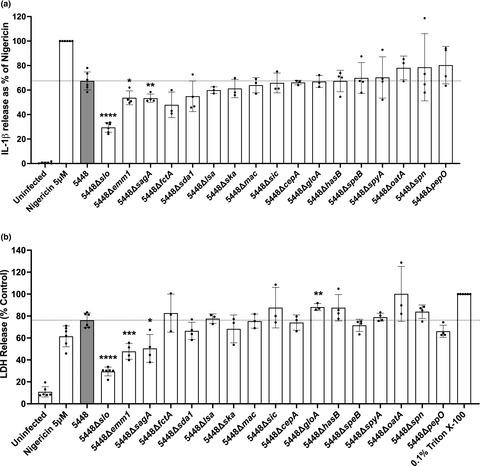当前位置:
X-MOL 学术
›
Immunol. Cell Biol.
›
论文详情
Our official English website, www.x-mol.net, welcomes your feedback! (Note: you will need to create a separate account there.)
Streptolysins are the primary inflammasome activators in macrophages during Streptococcus pyogenes infection
Immunology and Cell Biology ( IF 4 ) Pub Date : 2021-08-30 , DOI: 10.1111/imcb.12499 Johanna Richter 1 , Mercedes M Monteleone 2 , Amanda J Cork 1 , Timothy C Barnett 1, 3 , Victor Nizet 4 , Stephan Brouwer 1 , Kate Schroder 2 , Mark J Walker 1
Immunology and Cell Biology ( IF 4 ) Pub Date : 2021-08-30 , DOI: 10.1111/imcb.12499 Johanna Richter 1 , Mercedes M Monteleone 2 , Amanda J Cork 1 , Timothy C Barnett 1, 3 , Victor Nizet 4 , Stephan Brouwer 1 , Kate Schroder 2 , Mark J Walker 1
Affiliation

|
Group A Streptococcus (GAS) is a Gram-positive bacterial pathogen that causes an array of infectious diseases in humans. Accumulating clinical evidence suggests that proinflammatory interleukin (IL)-1β signaling plays an important role in GAS disease progression. The host regulates the production and secretion of IL-1β via the cytosolic inflammasome pathway. Activation of the NLR family pyrin domain-containing 3 (NLRP3) inflammasome complex requires two signals: a priming signal that stimulates increased transcription of genes encoding the components of the inflammasome pathway, and an activating signal that induces assembly of the inflammasome complex. Here we show that GAS-derived lipoteichoic acid can provide a priming signal for NLRP3 inflammasome activation. As only few GAS-derived proteins have been associated with inflammasome-dependent IL-1β signaling, we investigated novel candidates that might play a role in activating the inflammasome pathway by infecting mouse bone marrow-derived macrophages and human THP-1 macrophage-like cells with a panel of isogenic GAS mutant strains. We found that the cytolysins streptolysin O (SLO) and streptolysin S are the main drivers of IL-1β release in proliferating logarithmic phase GAS. Using a mutant form of recombinant SLO, we confirmed that bacterial pore formation on host cell membranes is a key mechanism required for inflammasome activation. Our results suggest that streptolysins are major determinants of GAS-induced inflammation and present an attractive target for therapeutic intervention.
中文翻译:

链球菌溶血素是化脓性链球菌感染期间巨噬细胞中主要的炎性体激活剂
A组链球菌(GAS) 是一种革兰氏阳性细菌病原体,可引起一系列人类传染病。越来越多的临床证据表明,促炎性白细胞介素 (IL)-1β 信号传导在 GAS 疾病进展中起着重要作用。宿主通过胞质炎性体途径调节 IL-1β 的产生和分泌。NLR 家族含 pyrin 结构域 3 (NLRP3) 炎症小体复合物的激活需要两个信号:一个是刺激编码炎症小体途径组分的基因转录增加的启动信号,以及一个诱导炎症小体复合体组装的激活信号。在这里,我们表明 GAS 衍生的脂磷壁酸可以为 NLRP3 炎症小体激活提供启动信号。由于只有少数 GAS 衍生蛋白与炎症小体依赖性 IL-1β 信号相关,我们研究了可能通过用一组同基因 GAS 突变株感染小鼠骨髓来源的巨噬细胞和人类 THP-1 巨噬细胞样细胞来激活炎性体通路的新候选物。我们发现溶细胞素链球菌溶血素 O(SLO)和链球菌溶血素 S 是增殖对数期 GAS 中 IL-1β 释放的主要驱动因素。使用重组 SLO 的突变形式,我们证实宿主细胞膜上细菌孔的形成是炎症小体激活所需的关键机制。我们的结果表明链球菌溶血素是 GAS 诱导的炎症的主要决定因素,并且是治疗干预的一个有吸引力的目标。
更新日期:2021-08-30
中文翻译:

链球菌溶血素是化脓性链球菌感染期间巨噬细胞中主要的炎性体激活剂
A组链球菌(GAS) 是一种革兰氏阳性细菌病原体,可引起一系列人类传染病。越来越多的临床证据表明,促炎性白细胞介素 (IL)-1β 信号传导在 GAS 疾病进展中起着重要作用。宿主通过胞质炎性体途径调节 IL-1β 的产生和分泌。NLR 家族含 pyrin 结构域 3 (NLRP3) 炎症小体复合物的激活需要两个信号:一个是刺激编码炎症小体途径组分的基因转录增加的启动信号,以及一个诱导炎症小体复合体组装的激活信号。在这里,我们表明 GAS 衍生的脂磷壁酸可以为 NLRP3 炎症小体激活提供启动信号。由于只有少数 GAS 衍生蛋白与炎症小体依赖性 IL-1β 信号相关,我们研究了可能通过用一组同基因 GAS 突变株感染小鼠骨髓来源的巨噬细胞和人类 THP-1 巨噬细胞样细胞来激活炎性体通路的新候选物。我们发现溶细胞素链球菌溶血素 O(SLO)和链球菌溶血素 S 是增殖对数期 GAS 中 IL-1β 释放的主要驱动因素。使用重组 SLO 的突变形式,我们证实宿主细胞膜上细菌孔的形成是炎症小体激活所需的关键机制。我们的结果表明链球菌溶血素是 GAS 诱导的炎症的主要决定因素,并且是治疗干预的一个有吸引力的目标。



























 京公网安备 11010802027423号
京公网安备 11010802027423号